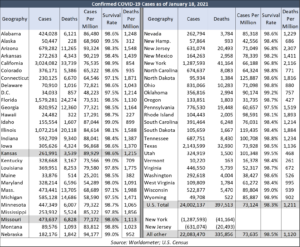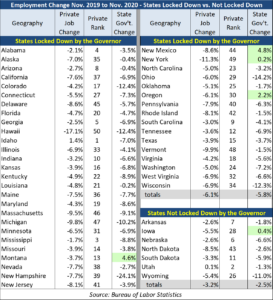A study conducted by researchers at Stanford University finds “no clear, significant beneficial effect of mrNPIs (more restrictive non-pharmaceutical interventions) on case growth in any country.” The Stanford study examined COVID-19 case growth in England, France, Germany, Iran, Italy, Netherlands, Spain, South Korea, Sweden, and the United States.
South Korea and Sweden implemented “less restrictive” NPIs but neither country implemented mandatory stay-at-home orders or business closures.
The authors conclude, “While small benefits cannot be excluded, we do not find significant benefits on case growth of more restrictive NPIs. Similar reductions in case growth may be achievable with less restrictive interventions.”
The potential harmful health and economic effects of NPIs were major influences for conducting the study.
“Because of the potential harmful health effects of mrNPI – including hunger, opioid-related overdoses, missed vaccinations4, increase in non-COVID diseases from missed health services, domestic abuse, mental health and suicidality, as well as a host of economic consequences with health implications – it is increasingly recognized that their postulated benefits deserve careful study. One approach to evaluating NPI benefits uses disease modeling approaches. One prominent modeling analysis estimated that, across Europe, mrNPIs accounted for 81% of the reduction in the effective reproduction number (Rt), a measure of disease transmission. However, in the absence of empirical assessment of the policies, their effects on reduced transmission are assumed rather than assessed. That analysis attributes nearly all the reduction in transmission to the last intervention, whichever intervention happened to be last, complete lockdowns in France, or banning of public events in Sweden.”
The authors employed a methodology that they believe “balances the strengths of empirical analyses while taking into consideration underlying epidemic dynamics. We compare epidemic spread in places that implemented mrNPIs to counterfactuals that implemented only less-restrictive NPIs (lrNPIs). In this way, it may be possible to isolate the role of mrNPIs, net of lrNPIs and epidemic dynamics.”
States not locked-down have fewer deaths per capita
The Sentinel’s analysis of COVID data from Worldometer found several interesting observations.
First, there is a wide disparity of cases and deaths per capita among the 43 states whose governors imposed statewide lockdowns. Hawaii has the lowest number of cases per million of population (17,291) as of January 18 and Tennessee has the most (100,708); the average is 72,073.
The states that weren’t locked down (Arkansas, Iowa, Nebraska, North Dakota, South Dakota, Utah, and Wyoming) have more cases per million of population (98,701) but they have 5% fewer deaths (1,151 vs. 1,214). The survival rate in the states not locked is also a little better (98.8% vs. 98.3%).

Less job loss in states not locked down
Along with fewer deaths per capita, the states not locked down have less job loss. The November jobs data from the Bureau of Labor Statistics shows they lost 3.2% of private-sector jobs compared to the year prior, but the lockdown state lost 6.1% of their jobs. The states allowed to stay open also lost fewer state government jobs (-2.5% vs. -5.8%).


